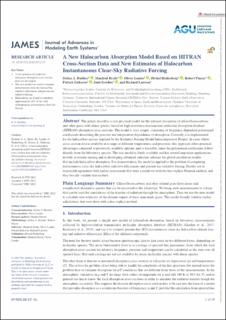| dc.contributor.author | Buehler, Stefan A. | |
| dc.contributor.author | Brath, Manfred | |
| dc.contributor.author | Lemke, Oliver | |
| dc.contributor.author | Hodnebrog, Øivind | |
| dc.contributor.author | Pincus, Robert | |
| dc.contributor.author | Eriksson, Patrick | |
| dc.contributor.author | Gordon, Iouli | |
| dc.contributor.author | Larsson, Richard | |
| dc.date.accessioned | 2024-02-19T14:18:41Z | |
| dc.date.available | 2024-02-19T14:18:41Z | |
| dc.date.created | 2022-12-14T04:08:56Z | |
| dc.date.issued | 2022 | |
| dc.identifier.citation | Journal of Advances in Modeling Earth Systems. 2022, 14:e2022MS003239 (11), 1-19. | en_US |
| dc.identifier.issn | 1942-2466 | |
| dc.identifier.uri | https://hdl.handle.net/11250/3118513 | |
| dc.description.abstract | The article describes a new practical model for the infrared absorption of chlorofluorocarbons and other gases with dense spectra, based on high-resolution transmission molecular absorption database (HITRAN) absorption cross-sections. The model is very simple, consisting of frequency-dependent polynomial coefficients describing the pressure and temperature dependence of absorption. Currently it is implemented for the halocarbon species required by the Radiative Forcing Model Intercomparison Project. In cases where cross-section data is available at a range of different temperatures and pressures, this approach offers practical advantages compared to previously available options, and is traceable, since the polynomial coefficients follow directly from the laboratory spectra. The new model is freely available and has several important applications, notably in remote sensing and in developing advanced radiation schemes for global circulation models that include halocarbon absorption. For demonstration, the model is applied to the problem of computing instantaneous clear-sky halocarbon radiative efficiencies and present day radiative forcing. Results are in reasonable agreement with earlier assessments that were carried out with the less explicit Pinnock method, and thus broadly validate that method. | en_US |
| dc.language.iso | eng | en_US |
| dc.publisher | AGU | en_US |
| dc.rights | Navngivelse 4.0 Internasjonal | * |
| dc.rights.uri | http://creativecommons.org/licenses/by/4.0/deed.no | * |
| dc.title | A new halocarbon absorption model based on HITRAN cross-section data and new estimates of halocarbon instantaneous clear-sky radiative forcing | en_US |
| dc.title.alternative | A new halocarbon absorption model based on HITRAN cross-section data and new estimates of halocarbon instantaneous clear-sky radiative forcing | en_US |
| dc.type | Peer reviewed | en_US |
| dc.type | Journal article | en_US |
| dc.description.version | publishedVersion | en_US |
| dc.source.pagenumber | 1-19 | en_US |
| dc.source.volume | 14:e2022MS003239 | en_US |
| dc.source.journal | Journal of Advances in Modeling Earth Systems | en_US |
| dc.source.issue | 11 | en_US |
| dc.identifier.doi | 10.1029/2022MS003239 | |
| dc.identifier.cristin | 2092810 | |
| cristin.ispublished | true | |
| cristin.fulltext | original | |
| cristin.qualitycode | 1 | |

